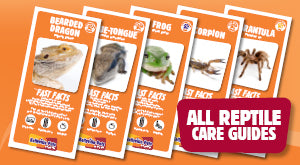 This comprehensive care guide will show you how to look after a Burrowing Cockroach in 3 easy steps
This comprehensive care guide will show you how to look after a Burrowing Cockroach in 3 easy steps
Fast Facts:
How long will my Cockroach live? They can live up to 10+ years
How big will it grow? They will grow approximately 75mm in length
What size of tank is recommended for my Cockroach? They require a plastic or glass enclosure around 30 x 30 x 30cm
What does a Burrowing Cockroach eat? - Dried eucalyptus (gum) leaves, fruit and vegetables
How easy is it to look after a Burrowing Cockroach? Cockroaches are a low maintenance pet
Burrowing Cockroach Housing
The Giant Burrowing Cockroach is a nocturnal species, meaning they are more active at night, generally spending their time foraging for food. During the day they can usually be found safely in their burrows.
In captivity, a small plastic or glass enclosure (approximately 30 x 30cm) is ideal to house 2-3 cockroaches, although bigger enclosures are recommended for larger groups of adults. The base of the enclosure should be covered with 5-10cm of sandy soil. Coco fibre mixed with sand and sphagnum moss is an ideal substrate for the cockroaches to burrow in.
Landscape the top of the soil with small pieces of wood and bark and then cover the soil with a layer of eucalyptus leaf litter.
Burrowing Cockroach Care
The Giant Burrowing Cockroach can grow to 75mm in length and weigh approximately 30grams when fully mature. This species is wingless and spends much of its days in burrows underground. These burrows can be as deep as one metre and usually contain a food storage area and living chamber connected by a series of tunnels. They can live up to 10 years and the mothers can support their young for up to three months before they become independent.
The enclosure should be misted with water 2-3 times per week to help maintain adequate moisture levels and allow the cockroaches to drink, however the soil should not be too wet. Giant burrowing cockroaches are very clean animals, and because of this not a lot of cleaning is required. In general wiping down the walls of the enclosure to remove any condensation when required and replacing the soil every 3 months is sufficient.
It is also important to remove any uneaten pieces of food (fruit or vegetable), to ensure they do not go mouldy.
Burrowing cockroaches are a great pet for all ages as they are easy to care for and are an interesting creature.
Burrowing Cockroach Feeding
The giant burrowing cockroach primarily feeds on dried and decaying eucalyptus (gum) leaves, although dried acacia (wattle) leaves and seed pods or grass can be given. They will also eat a variety of vegetable matter including apple, carrot, corn and spinach.
Giant burrowing cockroaches will also feed on small pieces of decaying wood or timber.
They do not require a bowl of water to drink from, provided the substrate is sprayed with water regularly.

Caution!
Giant burrowing cockroaches are extremely sensitive to chemicals and sprays.
Do not use any fly sprays, deodorants or air fresheners near their enclosures as it may kill them.
We have created a Shopping list to show what you need to look after a Burrowing Cockroach:
- Enclosure; 30cm x 30cm x 30cm
- Substrate (coco fibre, sphagnum moss)
- Thermometer
- Water sprayer
- Eucalyptus leaves
- Fruits and vegetables
Common health issues in Burrowing Cockroaches
Stress: Handling should be kept to a minimum or this can cause stress to the animal.
Lethargic/Slow Movement: If the temperature or the humidity is too low, this can cause lethargy.
Red flags
Is your Burrowing Cockroach showing any of the signs of disease or illness? If yes, please consult your reptile vet.
- Loss of appetite
- Lethargy




At Kellyville Pets, we encourage responsible pet ownership.
CARE GUIDE © Copyright 2016 Kellyville Pets - All information found in this care guide is based upon our own experience. The information provided is not the only information available. In any medical situations, you should always consult your vet, including questions regarding your pet's diet.










